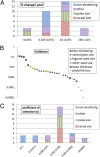Convergent evolution and parallelism in plant domestication revealed by an expanding archaeological record
- PMID: 24753577
- PMCID: PMC4035951
- DOI: 10.1073/pnas.1308937110
Convergent evolution and parallelism in plant domestication revealed by an expanding archaeological record
Abstract
Recent increases in archaeobotanical evidence offer insights into the processes of plant domestication and agricultural origins, which evolved in parallel in several world regions. Many different crop species underwent convergent evolution and acquired domestication syndrome traits. For a growing number of seed crop species, these traits can be quantified by proxy from archaeological evidence, providing measures of the rates of change during domestication. Among domestication traits, nonshattering cereal ears evolved more quickly in general than seed size. Nevertheless, most domestication traits show similarly slow rates of phenotypic change over several centuries to millennia, and these rates were similar across different regions of origin. Crops reproduced vegetatively, including tubers and many fruit trees, are less easily documented in terms of morphological domestication, but multiple lines of evidence outline some patterns in the development of vegecultural systems across the New World and Old World tropics. Pathways to plant domestication can also be compared in terms of the cultural and economic factors occurring at the start of the process. Whereas agricultural societies have tended to converge on higher population densities and sedentism, in some instances cultivation began among sedentary hunter-gatherers whereas more often it was initiated by mobile societies of hunter-gatherers or herder-gatherers.
Keywords: Neolithic; agriculture; archaeobotany; archaeology; vegeculture.
Conflict of interest statement
The authors declare no conflict of interest.
Figures



References
-
- Purugganan MD, Fuller DQ. The nature of selection during plant domestication. Nature. 2009;457(7231):843–848. - PubMed
-
- Fuller DQ, Allaby RG, Stevens C. Domestication as innovation: The entanglement of techniques, technology and chance in the domestication of cereal crops. World Archaeol. 2010;42(1):13–28.
-
- Laland KN, Odling-Smee J, Feldman MW. Niche construction, biological evolution, and cultural change. Behav Brain Sci. 2000;23(1):131–146. discussion 146–175. - PubMed
Publication types
MeSH terms
LinkOut - more resources
Full Text Sources
Other Literature Sources

